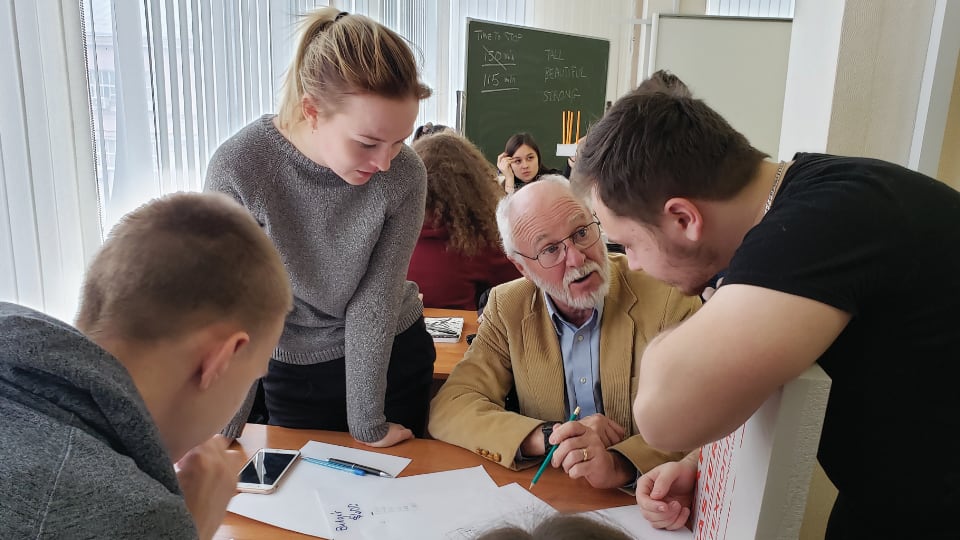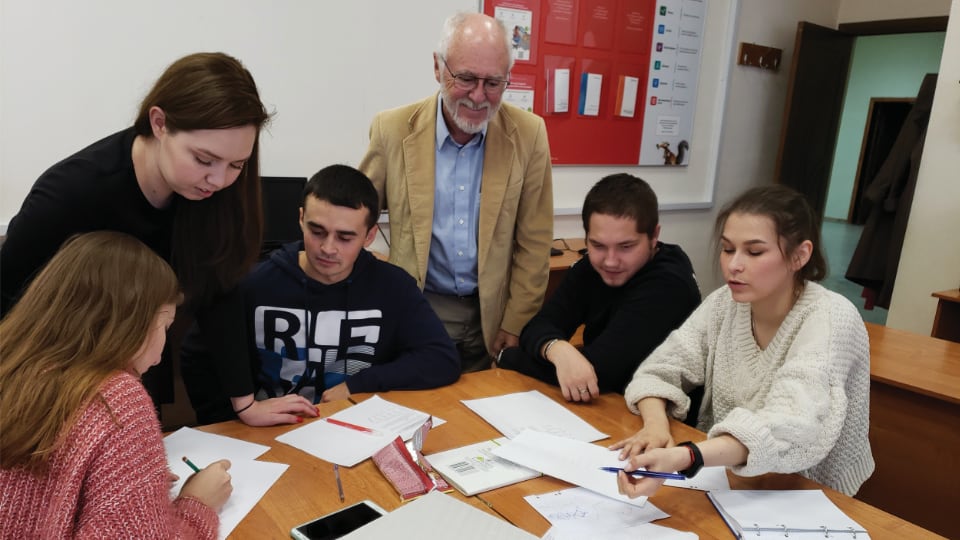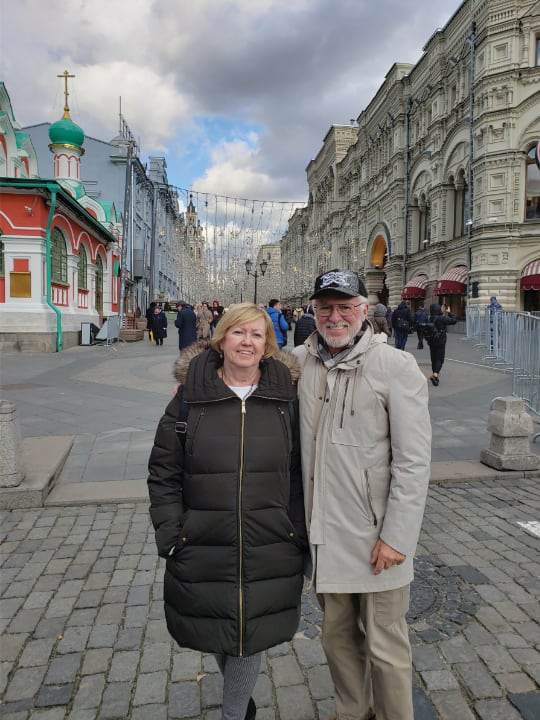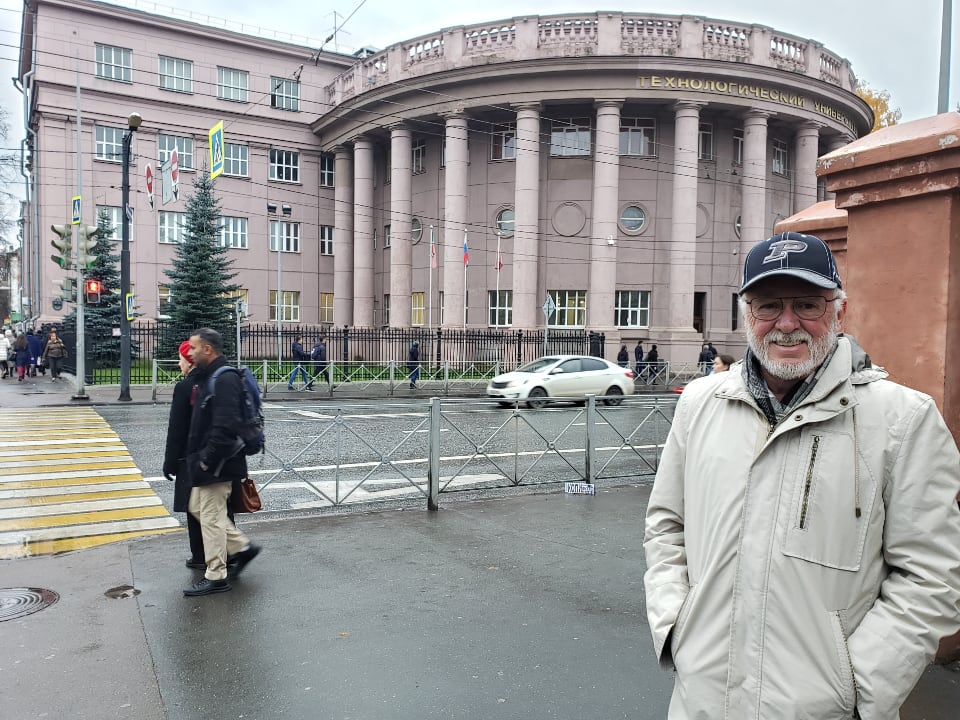
In a world that is increasingly multicultural and infused with technology, good team dynamics are essential for success. A Purdue Polytechnic professor is using a Fulbright Scholarship to study intercultural and gender influences at play in team dynamics at a Russian university. He’s also helping to infuse Polytechnic-style active learning into their curriculum.
Phillip Sanger, professor of electrical and computer engineering technology, is among eight Purdue faculty who won Fulbright U.S. Scholar Awards for 2019-20. His research, “Project Management Innovation Curriculum and Multicultural Team Dynamics,” is underway at Kazan National Research Technological University, located in Kazan, the capital city of the Republic of Tatarstan, Russia.
The demographics of science and engineering
When it comes to achievement, Sanger believes a group’s successful performance is linked to diversity in the composite of a team’s individual traits. His belief comes from decades of experience in industry and academia.
Sanger began working in industry as an engineer and scientist in 1974. He joined Western Carolina University as an associate professor in 2004 and Purdue as a full professor in 2012. Sanger also spent the last 14 years developing team-based multidisciplinary capstone project courses with industry sponsors.
Since Purdue has one of the largest international student populations in the country, there are often students of many nationalities working together in the capstone program in the Polytechnic’s School of Engineering Technology – and this provides a unique opportunity for research. While they work together for an entire school year on real-world problems for industry clients, Sanger observes the dynamics of their teamwork.
“Capstone projects serve as a bridge between academic studies, which are often neat and tidy, and the global engineering workplace, which is often messy and complicated,” said Sanger.
The goal of the research, Sanger said, is to achieve a better understanding of how to form effective, high-performance teams.
To date, over 600 students have completed more than 200 capstone projects, including a dozen projects in which students from Purdue and international universities formed transcontinental teams. Those projects provide Sanger the opportunity to observe even deeper levels of multiculturalism as students work to overcome extra challenges of distance and language.

But although there are many opportunities on campus to study the dynamics of multicultural teams, Purdue hasn’t yet succeeded in attracting a sufficient quantity of female students to achieve gender balance in the Polytechnic’s capstone teams. For that, Sanger looks to Kazan National Research Technological University (KNRTU) in Russia, where over 50% of students in science and engineering programs are female.
Purdue Polytechnic would benefit by achieving a gender balance that isn’t so “dramatically different,” he said.
In the United States, it’s easier said than done. KNRTU achieved it through a combination of historical, cultural and sociological factors. To understand how the Russian university achieved gender balance in these STEM fields, Sanger suggests we look at basic demographics. Worldwide, the gender ratio is 101.8 men per 100 women, according to 2015 United Nations data. In the U.S., there are 98.3 men for every 100 women.
In Russia, though, there are currently only 86.8 men per 100 women. The region has been predominantly female since at least World War II, when many Soviet men died in military service. Women have been playing major roles in engineering since then.
“The Soviet system allowed women to succeed in science and engineering,” said Sanger. “Sixty percent of engineers were female, and they held many leadership positions. There were two Russian women in space long before the United States even allowed women to be astronauts.”
On the other hand, even though there are more women enrolled in engineering, many do not continue in the discipline as a career. Russian society in general is male-dominated and often chauvinistic, Sanger said. “It’s an interesting contrast.”
The high percentage of women in science and engineering is not the only notable feature of the Kazan demographic, said Sanger.
“Kazan is where the European/Russian Orthodox culture meets with the Tatar/Muslim culture,” he said. “Overlaying the gender issue is the cultural issue. Not only are there more women enrolled, but about half are European and half are Tatar (Turkic-speaking). The role of women in Muslim culture is quite different than it is in the Orthodox culture.”

What can American educators learn from this? Sanger is exploring how to better capitalize on the diversity of social skills that women bring to team dynamics. He’s also seeking a deeper understanding of the influence that culture has on team dynamics.
“This is most important when we in the U.S. have so few women in our engineering community,” Sanger said. “How do we benefit from that diversity? I don’t think that the Russians have figured out how to capitalize on this special situation either, so we will be learning together.”
Fulbright Scholarship enables sharing Purdue Polytechnic’s strengths
The engineering technology programs in Purdue Polytechnic and at KNRTU employ different educational approaches. Although there are some exceptions, Russian professors rely on traditional oral lectures. In addition, project management, which Sanger notes is essential to efficient team operation, is not a regular component of the technical education of Russian undergraduate students.
“In general, they are not comfortable with a project-based learning approach,” said Sanger. “At Purdue Polytechnic, we use problem-based learning with lots of interaction and hands-on activities. In my experience with Russian students, they love active learning even though they feel it’s more work for them. But their professors are reluctant to transform their pedagogical style to the hands-on approach. After all, in their minds, the lecture style has worked for ages, so why change?”
 Through a Fulbright specialist grant in 2013, Sanger completed a six-week project at Northern Arctic Federal University (NArFU) in Arkhangelsk, Russia, on a university-wide project management initiative. He also delivered several workshops and short courses at KNRTU from 2011 to 2016. When he was named a Fulbright Scholar for 2019-20, Sanger wanted to transform his earlier projects in Russia into something that would be sustainable.
Through a Fulbright specialist grant in 2013, Sanger completed a six-week project at Northern Arctic Federal University (NArFU) in Arkhangelsk, Russia, on a university-wide project management initiative. He also delivered several workshops and short courses at KNRTU from 2011 to 2016. When he was named a Fulbright Scholar for 2019-20, Sanger wanted to transform his earlier projects in Russia into something that would be sustainable.
“My project-based learning (PBL) style matches well with an educational transformation that KNRTU desires, and it was received by students with excitement and enthusiasm,” Sanger said. “The goal for this grant is to create a four-year spine of courses – not a curriculum, but a kind of scaffold onto which their major study can be attached. Students will learn to manage real-world projects in challenging multicultural teams.”
The spine will be primarily extracurricular, serving as an interdisciplinary enhancement to a student’s disciplinary curriculum. One of KNRTU’s goals is to stimulate innovation, and Sanger hopes his work will further enable that goal. This fall, he’s teaching at every level of the university, from first-year students through seniors, to progressively develop the collaborative working skills and attitudes needed to be successful.
“The project management/innovation (PMI) curriculum spine needs to be sustainable when my Fulbright grant period is complete,” said Sanger. To accomplish that, he is enlisting, recruiting and training KNRTU faculty to continue the series of courses after his visit concludes by co-teaching the courses with them during his second semester in Kazan.
Sanger’s collaboration with Russian faculty represents a continuation and broadening of the efforts he made during earlier visits to the country.
“During my shorter experiences in Russia, I connected with colleagues who are interested in and willing to implement PBL techniques and apply project management skills in their courses,” he said. Professors come from departments of engineering, language, innovation, business, economics, history, psychology and education.
“This cross-disciplinary dimension is exciting to me and offers the potential of a true cross-disciplinary aspect to the PMI spine,” said Sanger. “The professors I’m working with are a narrow slice of the general faculty, but they also represent a critical mass of transformative talent. We’re working together to make the PMI spine sustainable, and it will be a lasting benefit to KNRTU.”

Connecting teaching to research
While developing and co-teaching courses in the PMI spine at KNRTU, Sanger is using a suite of five survey tools to enhance students’ team experiences and provide a window into understanding their team dynamics.
Three survey tools help educate students about the individual traits each possesses and how they affect team dynamics. The surveys help them learn about the following:
- Individual personality traits, through measurements of extraversion, emotionality, conscientiousness and agreeableness.
- Conflict management style preferences, through measurements of dominating, avoiding, integrating, accommodating and compromising.
- Leadership style preferences through 14 elements, including five that are self-reported and nine from a 360-degree external survey.
One survey explores the functioning of their teams through peer-to-peer feedback. The remaining survey measures overall team health by focusing on many vantage points: cooperative conflict management; role clarity; strategy planning, monitoring and assistance; goal progression; coordination; workflow; contribution equity; healthy, fact-driven conflict; lack of personal conflict; trust; constructive controversy; exploitive learning; and exploratory learning.
“The goal for this grant is to create a four-year spine of courses — not a curriculum, but a kind of scaffold onto which their major study can be attached.”“We examine these same elements at Purdue,” Sanger said, “and we will use them at KNRTU to facilitate conversations on how to improve team performance.”
Data from these surveys can be useful for exploring other factors that lead to successful teams, and Sanger believes the information will help refine ongoing studies at Purdue of senior capstone teams in the Polytechnic’s School of Engineering Technology.
“With the mixed cultural traits and a minority of men at KNRTU, the resulting team dynamics could lead to useful lessons learned and a model for more successful team dynamics at both Purdue and KNRTU,” Sanger said.
Third time’s a charm
In addition to his present two-semester stay at KNRTU and his 2013 project at NArFU, Sanger was awarded a Fulbright research grant in 1970, right after earning his bachelor’s degree, for studies in France.
“I have always enjoyed engaging internationally with colleagues and students abroad. I find experiencing different cultures exciting and challenging,” said Sanger. “I feel very honored to have been selected for a third time. At this stage in my career, I look at this Fulbright grant as an opportunity to give back to the academic community, and I hope to leave behind a transformative legacy at KNRTU.”
Sanger also notes that this is an interesting time for Americans to visit Russia.
“For most Russians that I have met in the past, particularly young students, I am the first American person that they have met,” Sanger said. “Peace comes from person-to-person interactions. Despite political tensions between our countries, I have always found the Russian people to be very friendly to Americans. My goal is to leave behind positive feelings with all the people with whom we interact.”

